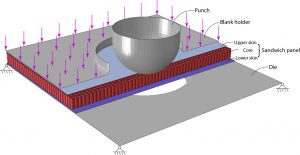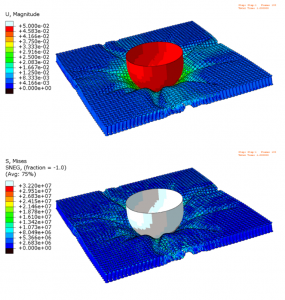
Simulation of forming 3D curved sandwich panels
Host Institution: The University of Nottingham
Lead Investigator: Nick Warrior
Co-Investigators: Oliver McGregor, Shuai Chen
Aims
The composite sandwich forming process offers a step-change in manufacturing rates for high performance structures. The process aims to form a 3D curved panel with varying thickness from a 2D sandwich format based on a matched tool forming set, offering an affordable high volume technology for carbon fibre chassis and other demanding structural applications. In order to exploit the full potential of this process a simulation tool is crucial to predict the forming behaviour and to design and optimise this process. This optimisation route will not be feasible via experimentation as too many parameters exist to solve by trial-and-error. At present, there is no suitable FE model available to simulate the forming process for curved sandwich panels. The novelty here is in the extension of existing fabric forming modelling techniques and the incorporation of the forming of a complex core geometry. The primary difficulties lie in the modelling of the behaviour of the core material and structure as well as the interface conditions between the core and the composite skins during forming.
Experimental tests are scheduled to collect the mechanical behaviour of the core material (that will be prepared as the inputs for FE simulations) and the global structural behaviour of the core, including bending and local crushing (that will be used to validate the core model). Experimental forming studies are planned to validate the complete FE composite sandwich model. The developed model and methodology will be applied in a forming demonstrator part with the industrial partner, Gordon Murray Design. This technical demonstrator study is to summarise general guidelines for industrial applications.
The aim of this feasibility study is to develop a numerical tool as an essential catalyst to accelerate this step change in composite manufacturing. The simulation tool will facilitate the improvement of the forming process and extend the opportunity to apply this low-cost technique in manufacturing complex parts in high volumes. FE simulation provides an effective and efficient way to determine a set of compatible process parameters to ensure a successful manufacturing solution. It is able to comprehensively visualise the forming behaviour of all areas, including the surface panels and the internal structure of the core.
The main objectives of this work are:
- To develop an explicit Finite Element (FE) model of the forming process of sandwich panels to understand the primary factors of producing a defect-free product
- To develop a feasible solution to manufacture high-quality curved sandwich parts. The developed FE model will be used to inform design choices and to drive future manufacturing process design and optimisation.

